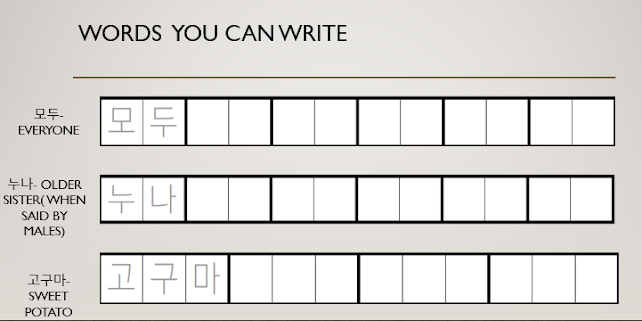Comprehensive Hangul from Zero, Part 1
Hangul is the main writing system of Korea. It’s famous for being easy to learn and in many
linguistic circles is considered genius. Prior to its invention in the 15th century, Korean used
the same Chinese characters as China and Japan. Japanese and Chinese children spend a
significant part of the school years devoted to learning the often-complicated Chinese
characters, but hangul can be learned in a few days for an average adult.
Korean, unlike other languages like Chinese and Japanese, have alphabets. There are 26 alphabets all together. ㅂㅈㄷㄱㅅㅛㅑㅐㅔㅁㄴㅇㄹㅎㅗㅓㅏㅣㅋㅌㅊㅍㅠㅜㅡ
Like English they are separated into vowels and consonants.
Hangul characters are “built” using consonant and vowel parts. Using these individual parts over 12,000 characters can be constructed. Don’t worry about memorizing the chart on this page, it is mainly to be used as a reference. The next few lessons will gradually teach you how to read and write hangul. You will be pleasantly surprised as to how easily you learn it.
In this lesson we will focus on the first five consonants and five vowels only to get used to creating the characters. Writing with the correct stroke order will make your writing neater…………….. A as in father, EO as in awe, O as in boat, U as in Zoo, AE as in men.
When creating a hangul character you will always start with a consonant, and then follow it with a vowel. Let’s look at some simple consonant + vowel combinations:
There are standing (vertical) and laying (horizontal) vowels. Standing vowels always “stand” to the right of the consonant. Laying vowels always “lay” below the consonant.
Here we can see different Consonant and vowel combination.
ㄱ can be pronounced like a G or a K. Typically at the beginning of a sentence or word you will hear ㄱ like a K, and if it is in the middle of a word it’s closer to a G.
ㄹ can be pronounced like an R or an L. Typically at the beginning of a sentence you will hear ㄹ like a R and in the middle more like L.
As you learn Korean you will find that, depending on the word, the sound of ㄱ and ㄹ will shift. In many cases you just have to learn how that particular word is pronounced.
The sound difference between ㅓ and ㅗ
The sound for ㅓ doesn’t really exist in English so it might be hard to master. It is certainly one of the sounds that Korean people will ALWAYS correct you on. One technique to getting closer to the right sound is this trick:
1. Shape your mouth as if you are going to say “AH”
2. Now say the sound “OH”. It should feel as if the sound is coming from the back of your throat
With the first five consonants and vowels it’s possible to create 25 different hangul characters. To practice correct stroke order, first trace the light gray characters, then write each character six times. We will practice with 11 of the possible 25 characters.
Using just the hangul from this lesson, we can already write many Korean words.
Connect the dots between each hangul and the correct Romanization. You can check your answers in the Answer Key at the back of the book.


















No comments:
Post a Comment